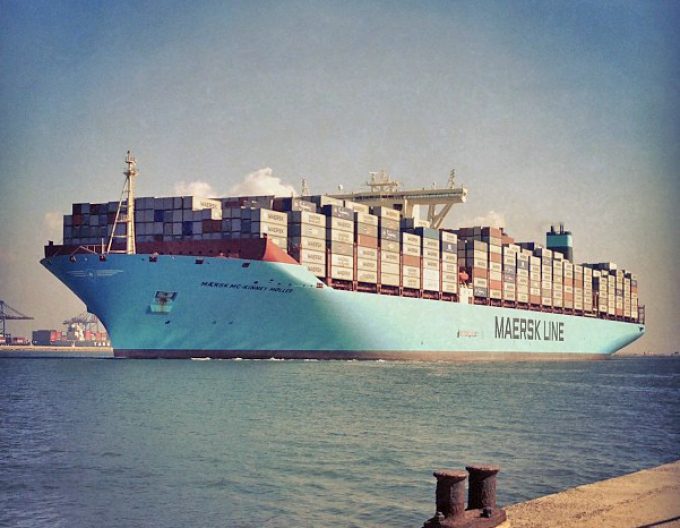Container spot rates have peaked as all major trades see prices fall
There was more evidence in this week’s container port freight markets that peak prices on ...
TFII: SOLID AS USUALMAERSK: WEAKENINGF: FALLING OFF A CLIFFAAPL: 'BOTTLENECK IN MAINLAND CHINA'AAPL: CHINA TRENDSDHL: GROWTH CAPEXR: ANOTHER SOLID DELIVERYMFT: HERE COMES THE FALLDSV: LOOK AT SCHENKER PERFORMANCEUPS: A WAVE OF DOWNGRADES DSV: BARGAIN BINKNX: EARNINGS OUTODFL: RISING AND FALLING AND THEN RISING
TFII: SOLID AS USUALMAERSK: WEAKENINGF: FALLING OFF A CLIFFAAPL: 'BOTTLENECK IN MAINLAND CHINA'AAPL: CHINA TRENDSDHL: GROWTH CAPEXR: ANOTHER SOLID DELIVERYMFT: HERE COMES THE FALLDSV: LOOK AT SCHENKER PERFORMANCEUPS: A WAVE OF DOWNGRADES DSV: BARGAIN BINKNX: EARNINGS OUTODFL: RISING AND FALLING AND THEN RISING

THE Alliance and Ocean Alliance vessel-sharing partners are taking full advantage of the 2M’s potentially messy divorce to beef up their east-west networks and grab market share.
Both Ocean and THEA members announced network upgrades last month, whereas, as the notice period for the disbandment of the 10-year VSA continued, 2M partners Maersk and MSC kept their strategy cards close to their chests.
However, these polar-opposite strategies are understood to be becoming more evident in operational discussions as the notice period ticks on, with one source telling The Loadstar communication was being kept to a minimum, and that the two carriers were “pulling in different directions” on capacity management.
During Maersk’s Q1 earnings call last week, CEO Vincent Clerc said the company would publish its standalone network plans “in due time, once we have operational control”.
He said: “We do believe we can actually create a network where we can increase asset intensity, so we will need less capacity to move the same amount of volumes, with less carbon footprint, more reliability and, also, very competitive transit times.
“We cannot do that today, in an alliance set-up, we will do that once we get out of the alliance,” he added.
Meanwhile, THEA partners Hapag-Lloyd, ONE, Yang Ming and HMM are busy upgrading their Asia-Europe loops following the delivery of newbuild 24,000 teu vessels.
Alphaliner reports that Japanese carrier ONE’s 24,000 teu ONE Innovation, currently on sea trials, is to be deployed on THEA’s Asia-North Europe FE3 loop, commencing its maiden voyage from Ningbo on 4 June.
According to the consultant, the vessel will replace the 16,010 teu HMM Garam, which will be cascaded onto THEA’s Asia-Med MD2 loop.
Alphaliner said: “Until recently the FE3 fleet consisted of 11 14,600-16,000 teu ships. The upgrade of the service started last month with HMM shifting the 23,964 teu HMM Le Havre and its sister ship HMM Gdansk to this loop.”
The FE3 service is the second THEA Asia-North Europe loop to be upgraded to 24,000 teu class vessels, after the FE4 loop deployed 11 24,000 teu ULCVs provided by HMM.
As new contract rates settle at “just above spot”, the 24,000 teu behemoths are becoming the new workhorses of the tradelane, with carriers refocusing on slow-steaming and maximising utilisation in order to produce positive voyage results. Moreover, some THEA backhaul sailings from North Europe and the US east coast to Asia are sailing via the longer-transit Cape of Good Hope route to save on Suez Canal toll fees and as a form of capacity management.
Indeed, the pressure is on for the shipping lines after a better-than-expected first quarter – due to the tailwind effect of unexpired higher contract rates – to break even in the next quarters of trading.
After Maersk’s Q1 results last week, it is the turn of Hapag-Lloyd, tomorrow, to update its outlook for the full-year. On 2 March, the Hamburg-headquartered carrier said it expected an ebit of $2.1bn to $4.3bn for the year, but cautioned that this forecast was “subject to considerable uncertainty”.
Comment on this article